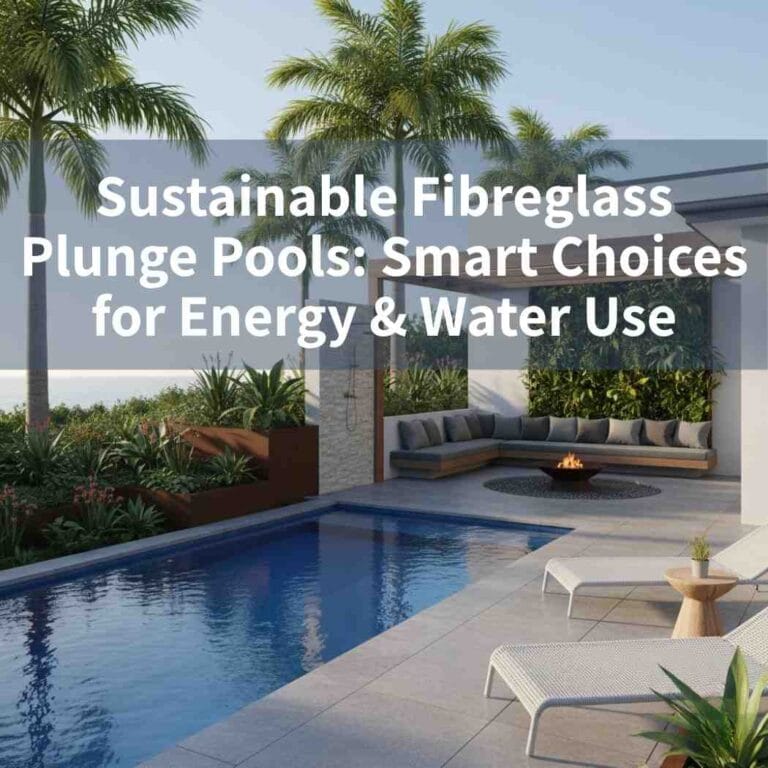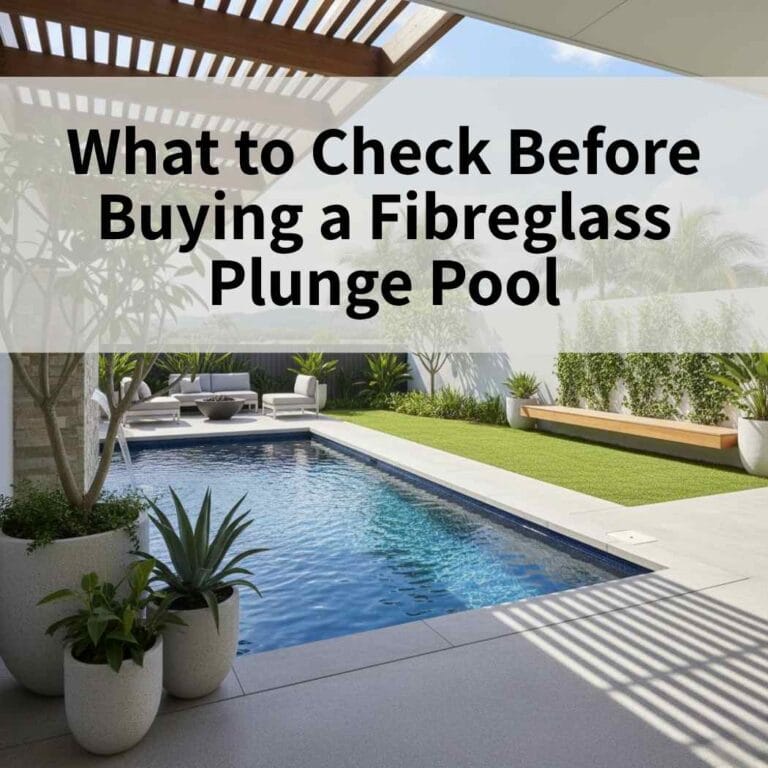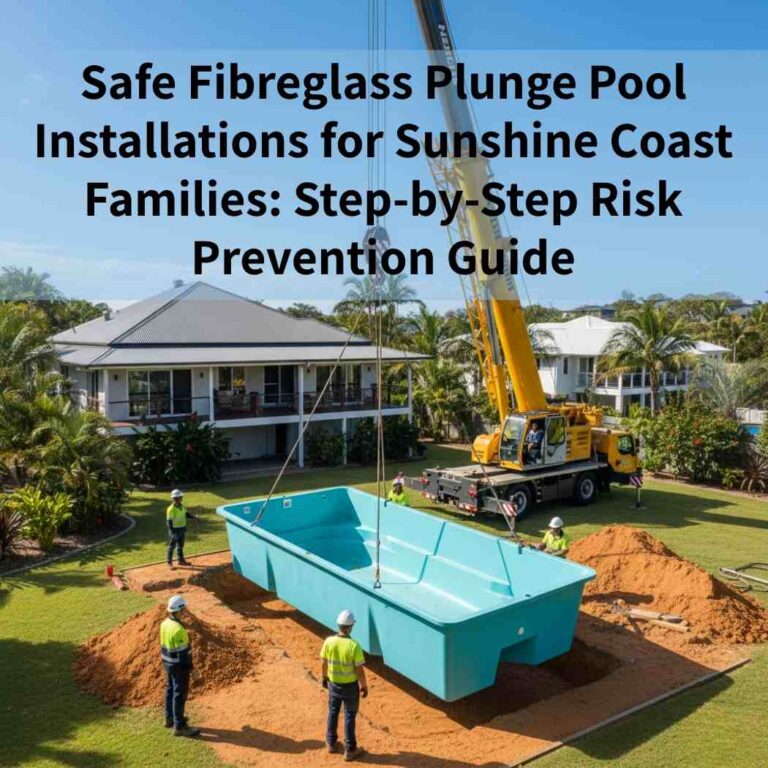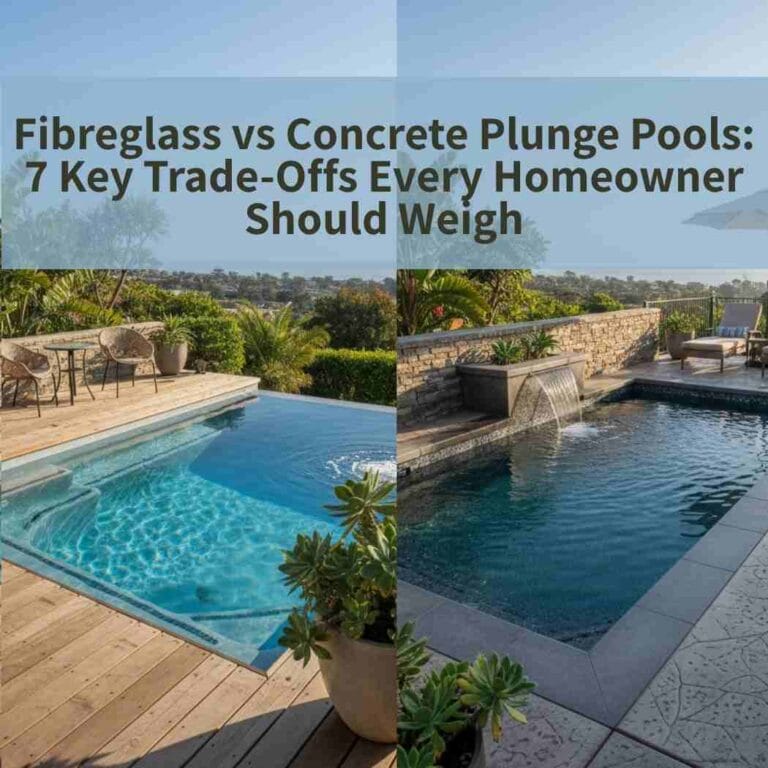At Plunge Pools Sunshine Coast, we help homeowners design and install fibreglass pools that suit their block, budget, and family needs. With years of experience building in coastal conditions, we know how to deliver pools that last in Queensland’s climate.
In this guide, you’ll learn everything about fibreglass pools, from shapes and sizes to costs, installation, pros and cons, and why they’re one of the best options for Sunshine Coast families.
Table of Contents
ToggleWhat Is a Fibreglass Pool?
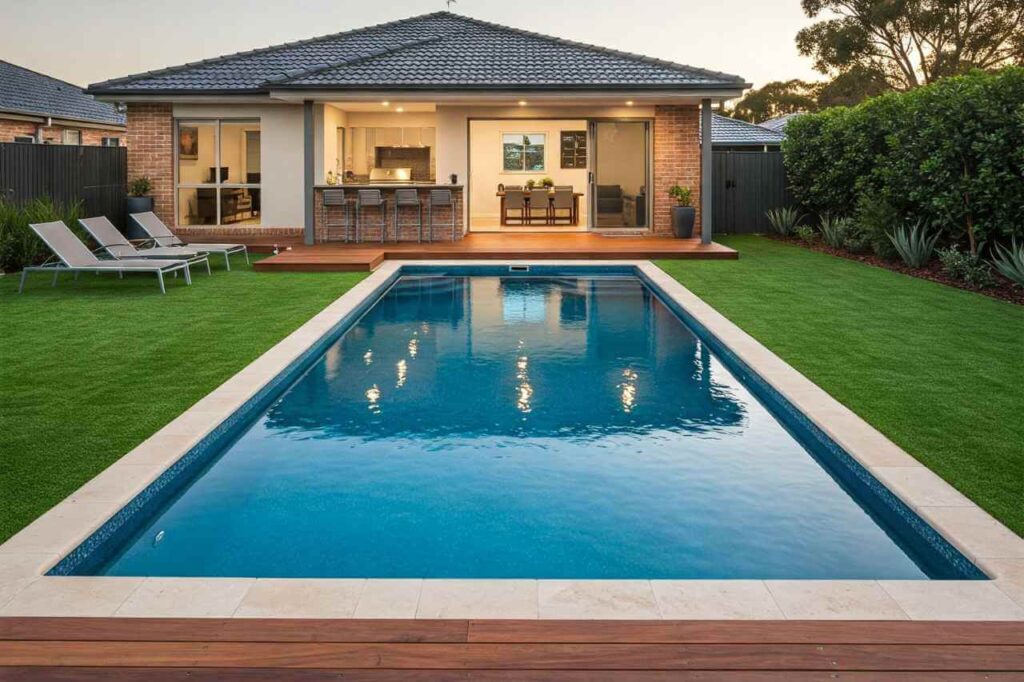
A fibreglass pool is a pre-made shell built in a factory and delivered in one piece. It’s placed into the ground with excavation and drainage. The biggest difference from concrete pools is speed, fibreglass pools install in weeks, while concrete builds often take months. For a deeper breakdown of these differences, see how fibreglass compares to concrete pools.
Fibreglass pools are created offsite in controlled conditions, which makes them stronger and more consistent in quality. Once the shell arrives, it’s craned into the prepared hole and secured with plumbing, backfilling, and drainage. This process avoids months of messy onsite building and means families can swim much sooner.
Compared to concrete pools, fibreglass has fewer design options because the moulds are pre-shaped. However, modern shells now come in a wide range of lengths, widths, and depths from family-sized pools to lap pools and entertainer designs. This balance of convenience, durability, and variety is what makes fibreglass pools so popular.
Unlike smaller plunge designs, our large fibreglass pool installations on the Sunshine Coast are built to deliver full-length swimming comfort and durable, family-safe construction.
Types of Fibreglass Pools
Fibreglass pools come in three main types: lap pools, family pools, and entertainer pools. Lap pools are long and narrow for fitness, family pools are wide and deep for everyday play, and entertainer pools are large formats designed for BBQs, birthdays, and big backyards.
1. Lap Pools (10–12m long)
Lap pools are long and slim, perfect for fitness swimmers or families who enjoy regular exercise. Their narrow shape makes them easier to fit into blocks with limited width while still giving enough length for daily lap swimming.
2. Family Pools (8–12m wide, 1.5–2m deep)
Family pools are designed for play, relaxation, and safe swimming for kids. With extra width and depth, they’re versatile for splashing, floating, or teaching children to swim. They’re the most common choice for Sunshine Coast households wanting a balance of fun and practicality.
3. Entertainer Pools (large formats 10m+)
Entertainer pools are the largest fibreglass options, created for hosting BBQs, birthdays, and weekend gatherings. Their generous size makes them a true backyard centrepiece, perfect for families who love having guests over or who want plenty of space for group swimming.
What are The Benefits of Fibreglass Pools for Families
The main benefits of fibreglass pools for families are low maintenance, child-safe surfaces, fast installation, and durability in coastal climates. They need fewer chemicals than concrete, are smooth and safe for kids, install in weeks, and resist algae in Sunshine Coast’s humid weather.
1. Low maintenance
Fibreglass pools need less chemical treatment than concrete pools. The smooth surface resists algae growth, so families spend less time cleaning and more time swimming.
2. Child-safe surface
The gelcoat finish is soft on skin and helps prevent scrapes or grazes, making fibreglass a safer choice for young children.
3. Fast installation
Most fibreglass pools can be installed in 2–6 weeks, compared to the 3–6 months often needed for concrete builds. This means families can enjoy their pool much sooner.
4. Durability in coastal climate
Fibreglass handles the Sunshine Coast’s humid and salty air better than many other pool types. Its non-porous shell is built to last in coastal conditions with minimal long-term issues.
Sunshine Coast’s humid air can encourage algae growth if not managed properly, learn how to maintain an algae-free fibreglass pool in coastal climates for year-round clarity.
What Shapes and Sizes Do Fibreglass Pools Come In?
Fibreglass pools come in 6–12 metre sizes, making them larger than plunge pools (2–6m). Medium pools suit smaller yards, family pools work for play and entertaining, and lap pools are longer for fitness. This range gives Sunshine Coast families flexibility for space and lifestyle.
Medium Pools (6–8m)
Medium pools are a practical choice for smaller backyards. They balance swimming space with yard fit, making them ideal for families who want a pool without losing too much garden area.
Family Pools (8–12m)
Family-sized pools are the most popular option. With extra width and depth, they’re perfect for kids, everyday fun, and backyard entertaining.
Lap Pools (10–12m)
Lap pools are longer and narrower, designed for regular exercise. They give swimmers enough length for fitness training while still fitting well in long or slim blocks.
Quick Comparison Table
| Pool Type | Size Range | Best Use |
|---|---|---|
| Medium | 6–8m | Smaller yards, balance of space |
| Family | 8–12m | Play, entertaining, kids |
| Lap | 10–12m | Fitness, training laps |
What Are the Potential Drawbacks of Fibreglass Pools?
The main drawbacks of fibreglass pools are structural issues like cracks if neglected, site limits on sloping or clay blocks, limited customisation compared to concrete, and long-term lifespan considerations such as resurfacing after decades. With proper care and a good builder, these risks are manageable.
Structural
If a fibreglass pool isn’t maintained correctly, issues such as shell cracking or osmosis (water penetration into the surface) may appear. These are rare but can happen if water balance is ignored for long periods.
Site Limits
Not every block is a perfect fit for fibreglass. Sloping land, rocky soil, or heavy clay can require extra excavation, soil stabilisation, or drainage work, which adds to cost and time.
Customisation
Fibreglass pools are pre-moulded, so design options are limited compared to concrete pools. While families can still choose from various lengths, widths, and add-ons, shapes and depths are less flexible.
Lifespan
Fibreglass shells last 20–30 years, but many will eventually need resurfacing or relining. Proper care delays this, but homeowners should expect some maintenance decades down the line.
How Is a Fibreglass Pool Installed?
Installing a fibreglass pool usually takes 4–6 weeks. The process includes site preparation, crane delivery of the pre-moulded shell, plumbing and filtration setup, coping and decking, and final landscaping with fencing. Each step ensures the pool is safe, functional, and council-compliant.
Step-by-Step Process
1. Site preparation
Soil is tested, the ground is excavated, and the area is levelled to create a solid base for the pool.
2. Crane delivery
The fibreglass shell is transported to site and lifted into place using a crane.
3. Plumbing and filtration
Pumps, pipes, and filtration systems are installed to keep the water clean and safe.
4. Coping and decking
Paving, tiles, or decking are added around the pool to create a finished look and safe entry points.
5. Landscaping and fencing
Final touches such as garden features, safety fencing, and compliance checks are completed.
For a detailed breakdown of every phase from excavation to final handover check our step-by-step guide to fibreglass pool installation.
While most installations are inground, certain sites allow partial or full above-ground setups. Learn how fibreglass pools can be installed above ground and what structural support they need.
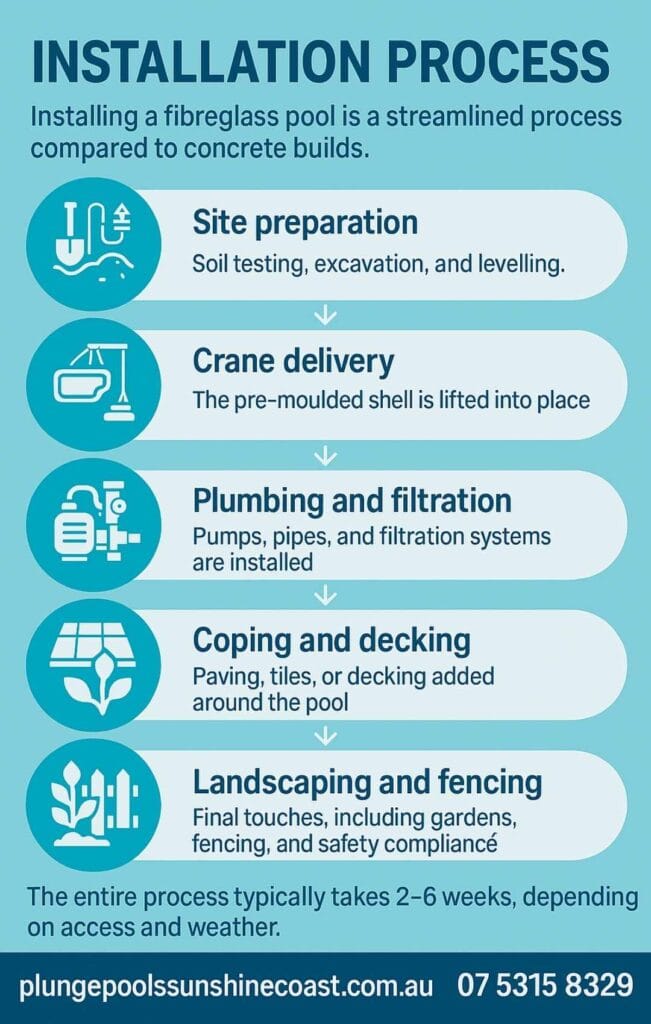
What Customisation Options Are Available for Fibreglass Pools?
Fibreglass pools can be customised with LED lighting, water features, heating systems, covers and smart pumps, and landscaping options such as decking or gardens. These add-ons make a pre-shaped pool more personal, functional, and a true centrepiece for family life on the Sunshine Coast.
LED lighting
Coloured LED lights add style and make night swimming safe and fun.
Water features
Jets, fountains, or cascades create movement, add sound, and give a resort-like feel.
Heating systems
Choose solar, gas, or electric heating to enjoy swimming year-round.
Covers and smart pumps
Energy-saving covers and automated pumps help reduce running costs and keep the water clean.
Decking, paving, or gardens
Surround the pool with timber decking, stone paving, or lush gardens to blend it into your backyard design.
Many homeowners also ask about tiling as part of their design. If you’re considering that finish, learn whether you can tile a fibreglass pool and how it’s done before planning your layout.
How Much Do Fibreglass Pools Cost on the Sunshine Coast?
For family-size fibreglass pools in the Sunshine Coast area, expect costs between $50,000 and $100,000. The final price depends on pool size, ease of access, and chosen extras like lighting, decks, or heating.
Fibreglass pool costs vary a lot. A simple shell in a flat yard with easy access will land nearer the low end. But steeper blocks, crane lifts, deep ends, extra landscaping or water features push the cost much higher.
| Pool Type | Typical Cost | Install Time |
|---|---|---|
| Fibreglass (large/community / family-scale) | $50,000 – $100,000 | 4 – 6 weeks |
| Concrete (custom builds) | $60,000 – $150,000+ | 3 – 6+ months |
| Plunge / compact fibreglass | $25,000 – $60,000 | 2 – 4 weeks |
Compare this to concrete and plunge options, fibreglass gives strong value especially when factoring long-term maintenance savings.
Prices can vary widely depending on access, size, and finish. To see detailed cost examples and factors that affect pricing, check our full guide on fibreglass pool costs.
For accurate pricing tailored to your yard and block type, get a free quote through Plunge Pools Sunshine Coast’s fibreglass pool installation experts, we’ll help you design a large family pool that fits your budget.
Is a Fibreglass Pool the Right Choice for Your Family?
A fibreglass pool is right for families who want a mid-budget pool, fast installation, and a child-safe surface. On the Sunshine Coast, large fibreglass pools cost $50,000–$100,000 and fit yards 6–12 metres long, making them ideal for fitness, play, and entertaining.
Checklist For Families
Budget fit
If your pool budget is between $50,000 and $100,000, fibreglass offers excellent value compared to concrete while still giving more space than a plunge pool.
Yard size
Best suited for blocks that can fit 6–12 metre pools. Small yards may be better with a plunge pool.
Family lifestyle
Ideal if you want a pool for kids’ play, family gatherings, or weekend BBQs. The smooth surface is gentle on skin and safer for children.
Fitness use
Longer lap-style fibreglass pools (10–12m) are perfect for daily exercise or swim training.
Quick installation
Most fibreglass pools are ready in 4–6 weeks, far faster than the 3–6 months needed for concrete builds.
For properties with tricky access or limited yard space, learn what makes a backyard suitable for an inground fibreglass pool before starting your build.
Do You Need Council Approval for a Fibreglass Pool on the Sunshine Coast?
Yes, all fibreglass pools on the Sunshine Coast need local council approval. Rules include safety fencing, drainage compliance, and using a licensed pool builder. Permits may also vary depending on your property.
When you plan your pool, the first step is getting council approval. This ensures the design meets Queensland’s safety laws and local building codes. In some cases, you may also need a development permit if your block is small, sloping, or has zoning restrictions.
Pool safety is a top priority. Fencing must follow AS1926.1 standards, at least 1.2 metres high with self-closing and self-latching gates. This prevents accidents and keeps the pool area child-safe.
Drainage and stormwater systems also matter. They must be designed to stop run-off from damaging your neighbour’s property or flooding your own yard.
To make the process easier, a licensed pool builder like Plunge Pools Sunshine Coast will handle applications, inspections, and compliance on your behalf. That way, your pool is approved and ready without the stress of navigating council paperwork.
How Do Families Enjoy Their Fibreglass Pools?
Families enjoy fibreglass pools for exercise, child-friendly play, entertaining guests, and everyday cooling off. The smooth surface makes them safe for kids, the length suits lap swimming, and the size is ideal for BBQs and birthdays. They quickly become the heart of backyard life.
Here’s how they enjoy:
Exercise and fitness
Lap pools give families space to swim daily laps or train for fitness in a safe, controlled environment.
Child-friendly fun
Shallow entries and smooth gelcoat finishes make fibreglass pools gentle on skin and safe for young children.
Entertaining guests
Family and entertainer-sized pools are perfect for hosting BBQs, birthdays, and weekend gatherings.
Everyday lifestyle
On hot Sunshine Coast days, fibreglass pools are the go-to spot for relaxing, cooling off, and creating family memories.
How Do Fibreglass Pools Compare to Concrete and Plunge Pools?
- Fibreglass vs Concrete: Fibreglass pools install faster, cost less, and need less upkeep, while concrete offers full customisation.
- Fibreglass vs Plunge: Fibreglass pools are larger and lifestyle-focused, while plunge pools are smaller, cheaper, and better for compact backyards.
Detailed Comparison
Fibreglass vs Concrete
Fibreglass pools are quicker to install, usually finished within 4–6 weeks, compared to 3–6 months for concrete. They are also cheaper overall and require less chemical use. However, concrete pools offer unlimited customisation in shape, depth, and design, which fibreglass can’t fully match.
Fibreglass vs Plunge
Plunge pools are typically 2–6 metres long, making them perfect for smaller yards or homeowners who want a pool at a lower cost. Fibreglass pools, on the other hand, range from 6–12 metres, offering more space for family play, entertaining, and exercise.
Beyond concrete and plunge designs, many homeowners also weigh up the pros and cons of vinyl vs fibreglass pools when planning their backyard build.
How Do You Maintain a Fibreglass Pool and How Long Does It Last?
Fibreglass pools are easy to maintain. Weekly care includes testing water and cleaning filters. Seasonal tasks involve shock treatments, servicing pumps, and using covers in winter. With proper care, a fibreglass pool shell lasts 20–30 years before major resurfacing is needed.
Seasonal Care
Weekly care
Keep the water balanced with simple chemical tests, brush the shell to prevent build-up, and clean the filter to ensure water stays clear.
Seasonal maintenance
Every few months, give the pool a shock treatment, service the pump, and use a cover during colder months. This protects the shell and reduces long-term running costs.
Longevity
A well-built fibreglass pool can last 20–30 years with only minor repairs along the way. After decades of use, resurfacing or relining may be needed, but fibreglass typically requires far less upkeep than concrete pools.
Pros & Cons Summary
| Feature | Fibreglass Pools | Concrete Pools | Precast Concrete Plunge Pools |
|---|---|---|---|
| Installation time | 4–6 weeks | 3–6 months | 2–4 weeks |
| Cost range | $35k–$65k | $50k–$100k+ | $35k–$60k |
| Maintenance | Low | High | Low |
| Customisation | Limited | Full | Limited |
| Size | 6–12m | Any size | 2–6m |
Pros of Fibreglass Pools
Fibreglass pools are installed in just 4–6 weeks, making them much faster than concrete. They also cost less to build and need fewer chemicals, making them easier for families to maintain long-term.
Cons of Fibreglass Pools
Because fibreglass shells are pre-moulded, there are fewer options for shapes and depths compared to fully custom concrete pools. They are also limited to around 6–12 metres, which may not suit those wanting a very large or unique design.
For a complete overview of strengths and weaknesses, check our detailed guide outlining fibreglass pool pros and cons.
Compared to Plunge Pools
Plunge pools are smaller (2–6 metres) and cheaper, which makes them a good choice for compact yards or lower budgets. Fibreglass pools, however, give more space for kids, entertaining, and exercise, making them better for active families.
Conclusion
Fibreglass pools are one of the best choices for Sunshine Coast families. They combine size, strength, and affordability, giving you more space than a plunge pool without the high cost or long build times of concrete. With quick installation, child-safe surfaces, and proven durability in coastal conditions, a fibreglass pool is built for everyday family life.
If you’re planning a full-sized pool that balances cost, strength, and family enjoyment, talk to our Sunshine Coast fibreglass pool specialists about design and installation options today.
FAQs
How long does it take to install a fibreglass pool?
Most fibreglass pools take 4–6 weeks to install, depending on site access and weather. This is much faster than concrete pools, which can take 3–6 months.
Are fibreglass pools safe for children?
Yes, fibreglass pools are child-friendly because of their smooth, non-abrasive surface. Many shells also include shallow entry steps and ledges, making them safer for kids.
How much does a fibreglass pool cost on the Sunshine Coast?
The cost typically ranges from $50,000 to $100,000+, depending on size, access, and extras. This makes fibreglass pools more affordable than concrete but larger and more versatile than plunge pools.
How long do fibreglass pools last?
A well-built fibreglass pool can last 20–30 years before major resurfacing is needed. With proper care, many pools last even longer in Sunshine Coast conditions.
Do fibreglass pools require council approval?
Yes, all swimming pools require local Sunshine Coast council permits and must comply with Australian Standards AS1926.1. This includes fencing, drainage, and safety requirements.

